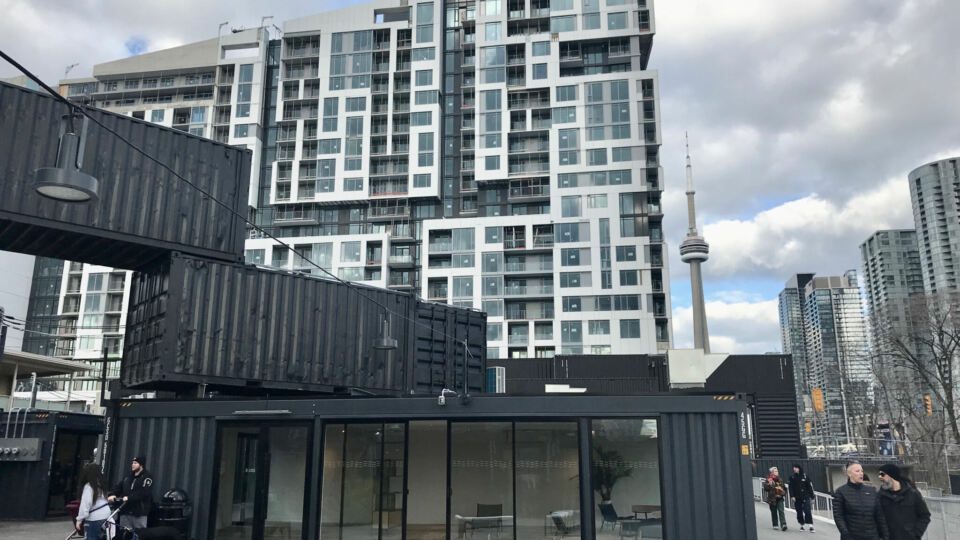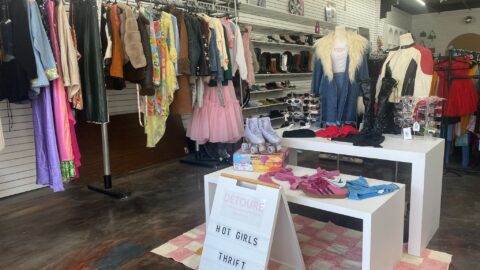Digital has created an easy entry point for brands of all sizes: whether a business is a corporate behemoth or just starting in the founder’s garage, they’re all in an open environment with equal access to consumers. But in the world of brick-and-mortar, access and entry are still big challenges.
Some property owners have strict requirements for new tenants, which makes it difficult for smaller businesses to break into physical retail. Other companies simply don’t have the long-term strategy or financial capital to validate long-term leases. That’s where stackt comes in.
Designed completely out of shipping containers, stackt is a Toronto-based marketplace that brings community connection, commerce and culinary experiences together. With its rotating calendar, stackt creates opportunities for the latest brands, artists, chefs and businesses to join the community experience, test a new store concept or break into physical retail for the first time. This “incubator platform” has become a big draw for brands large and small to “connect and test new ideas within the community,” noted Jessica Lynch, VP of Strategy and Development for stackt in an interview with Retail TouchPoints.
Brands’ desire to be more embedded into their communities has made stackt a vibrant platform in a fast-growing market: Lynch noted that demand for space ranges from one-off pilot programs to more long-term, community-driven activations.
“The vision behind the curation is to ensure a mix of local, small and international retailers,” Lynch explained. “The essence of the approach surrounds itself around an incubator platform built within a community ecosystem that is relevant to multiple categories.”
Lynch shares more about stackt’s evolution and how it’s cultivating a community-driven experience for brands and consumers.
Retail TouchPoints (RTP): Stackt opened in April 2019. What was the initial goal for the business and how has it evolved, especially over the past 12 months?
Jessica Lynch: Since inception, stackt’s vision was to redefine how underutilized land works, in conjunction with the goal of building cultural, community-driven initiatives. We’ve always approached the business with the mindset of delivering forward-thinking models that provide greater opportunity for businesses and brands, while also engaging with the community through purpose-driven initiatives that create impact. We’ve stayed true to the vision and ethos of stackt over the past year.
Advertisement
RTP: How would you define the stackt value proposition for retail businesses specifically?
Lynch: Stackt provides an opportunity for entrepreneurs, small businesses and Fortune 500 companies to overlap and connect with the community in a multifaceted ecosystem. Retail is a key component of many brands, and the value of a physical retail presence remains important. However, expanding into brick-and-mortar can be challenging for brands that want to secure a high-traffic retail space, especially if they need to meet specific tenant criteria set out by landlords, do not have the ability to commit financially to a long-term lease or do not have the necessary capital investment required.
The innovative leasing system established by stackt provides solutions for small, large, new and established brands alike. Our unique urban environment and platform provides businesses with access to storefronts and delivers an ideal way to build their brand before expanding. Once tenants are onboarded, they are further supported in this unique ecosystem with programming, marketing and community collaboration resources and tools. We encourage tenants to explore different types of opportunities outside of their four walls to engage with consumers and generate further exposure for their brand.
RTP: More than 1,000 businesses have operated inside stackt since its inception. How do you accommodate businesses with different needs, goals and budgets?
Lynch: Storefront accessibility is a big challenge for many small and local brands, due to a lack of credibility and historical results some emerging brands may [not] be able to provide. We saw this as an opportunity to provide a leasing solution that’s atypical: the leases are flexible, ranging from one week to two years, and the shipping containers’ smaller dimensions provide for easy buildouts. This removes the onerous financial commitments more traditional storefronts in Toronto would face, with a five- to 10-year lease coupled with a larger capital requirement. As an added benefit, all units offer a turnkey space, which includes WiFi, brand signage printed by stackt, iPads and the latest POS hardware.
RTP: Which elements of the stackt experience resonate most with consumers?
Lynch: Toronto, Canada has been booming for years. The population is growing rapidly. Condos are going up faster than we can imagine and that is putting pressure on available space in general. All those people need public spaces to actually enjoy their neighborhoods. And in downtown Toronto, most residents would agree — there are simply not enough public spaces.
Stackt is a place for local commerce, cultural exploration and community engagement. Stackt is committed to ever-changing through art, programming, culinary experiences and retail while adapting to the surrounding population’s needs.
A consumer can expect a new experience every visit due to our ever-evolving platform. But they still experience the comfort of their community brand. More than 70% of our public property resides within an outdoor landscape that provides a safe and welcoming environment during the ongoing pandemic.
RTP: Why make the space out of shipping containers? What’s the intent and impact of this decision?
Lynch: The project delivers an industry-transformative concept and designs a modular, prefabricated and turnkey market in downtown Toronto. At the same time, it also ensures minimal disturbance and impact on the land. Built on 100,000 square feet, stackt transformed the land using mostly materials (old and new shipping containers) that can be recycled or were to be discarded. We found a more innovative way to reduce waste while giving back to the community. Shipping containers have been the main source of shipping goods across the world for more than 60 years and the reality is, these containers have ended up all over the world with large surpluses of them adding up. We found a cool way to repurpose these containers and expand their use toward engaging with the public.
RTP: What is stackt’s biggest priority for 2022?
Lynch: Our biggest priority for 2022 is to continue toward the vision of creating an inclusive and inspiring marketplace that provides a robust ecosystem for businesses and consumers to intersect with purpose.
RTP: What key learnings have you uncovered while building stackt that would apply to other retailers and brands that want to bridge the gap between community and commerce?
Lynch: Place value on defining what your brand stands for and how to deliver key consumer experiences. Experiences drive conversation, consideration and conversion.









